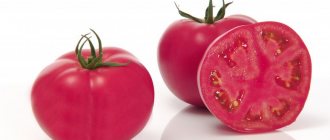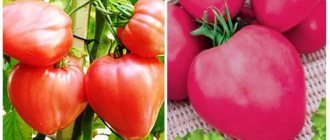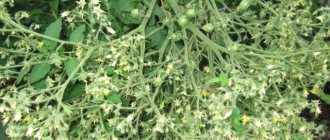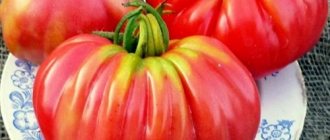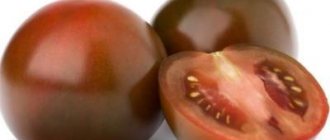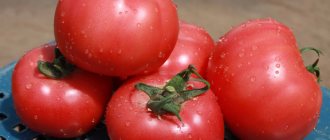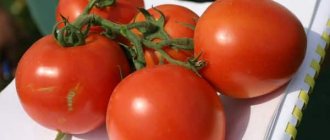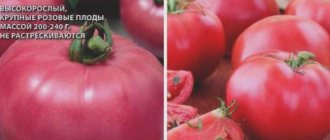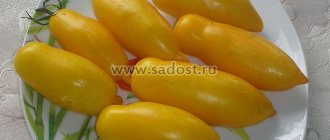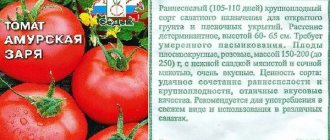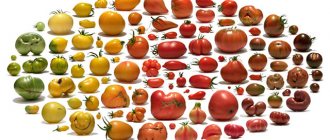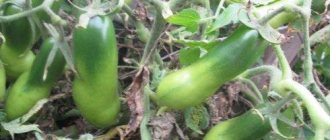Handsome Merchant - well done
How tomatoes developed before this, I told in previous reports: Tomato Merchant - well done - stage 1. The tomato “Merchant Well done” received registration - stage 2.
The tomatoes planted in the greenhouse quickly gained growth and developed well. And on June 1, my merchants bloomed.
Tomato “Merchant-well done”. She formed the first flowers of the plant into two trunks and cut off all the extra shoots. I pulled the cord and wrapped the plants around it. Tomato “Merchant-well done”. First ovaries June 8, first ovaries. Plants are developing well. Care consists of regular weeding and watering with warm, settled water from a container. Once every three weeks I fertilize with Agromaster fertilizer according to the instructions. Two weeks after the ovary appeared, I treated it with Ridomil. Then, after two weeks, she was treated with phytosporin, which was repeated two more times after 2 weeks. During the day, the temperature in the greenhouse rose to 30 degrees, at night in the greenhouse it was 16-18 degrees. During the day, the doors to the greenhouse were open all the time. Tomato “Merchant-well done”. That's how abundant there are a lot of tomatoes on the bushes. The height of one bush is 1 m 20 cm, the height of the second bush is 1 m 30 cm. Higher than what is written on the package.
The tomatoes on different bushes turned out different for me - on some they were only round, on others they were round and some were oval. Apparently, there was a re-sort.
Tomato “Merchant-well done”. The fruits are elongated and lighter in color. Tomato “Merchant-well done”. Red and round tomatoes Tomato “Merchant-well done”. Fruits in section
Tomatoes from different bushes practically did not differ in taste. Tomatoes are quite large in weight.
Tomato “Merchant-well done” - delicious beauties
Tomato Merchant - well done - my attempts to grow large tomatoes were a success!
My experience in growing tomatoes is limited. More precisely, I have good gardening experience, but I have previously grown only a very limited list of tomato varieties. As it was customary for my mother to grow two or three proven varieties, so I did.
Only in the last couple of seasons have I begun to experiment with many different varieties, thanks to the 7 Dachas website and our summer residents, who introduce us to different amazing varieties of this vegetable. And thanks to the agricultural company Aelita, this year I had the opportunity to test for myself not only a new variety of tomato, but a new species for me - a large-fruited beef tomato.
Over the summer I carried out several feedings: June 20 - fertilized with mullein infusion. On June 22, I loosened the soil around the bushes and poured compost soil around them. July 1 - fed with organic-mineral fertilizer.
August 9 - first tomato harvest. In our conditions of Siberia, I don’t wait for the tomatoes in the open ground to ripen on the bush, the summer is short, the next tomatoes still need time to gain weight. That’s why I pick them green and send them for ripening, just like my mother did. I collected 1.361 kg from two bushes.
The weight of the largest was 301 grams, while the manufacturer declared 400 grams. Not a very good result. But I repeat that this is my first time trying to grow such large tomatoes. Before this, my favorites were cherry and medium tomatoes for canning.
I am, of course, far from a professional in growing tomatoes. But whatever the result is, that’s what it is, nothing can be done for now. I will study further.
In total, from two bushes planted in the OG, I got: 1.360 + 2.171 = 3531 kg. From one bush 1.765 kg. Very little. But we must also take into account the fact that in the second half of the summer I had absolutely no time to care for the tomatoes. I didn’t breed them, but they were weakly overgrown with stepsons. I practically didn’t water, there was enough rain.
And I didn’t have enough time for a bush in the greenhouse. It grew on its own, only in the summer several large red tomatoes were picked from it. But today the first snow is already falling outside, I ran to the greenhouse, and even the last tomato bushes haven’t been harvested there yet. But I found these: one red, one green “merchants”)))
Today there will be a salad!
This first snowball will still melt. But it’s still winter-like cold outside.
And in cross-section it’s downright saccharine!
This is the kind of good Merchant I got. Due to lack of time due to constant work, everything else has to be done only at a gallop and in raids. But I still get pleasure and satisfaction from the work done and the resulting harvest! Thanks to the agricultural company Aelita! Let's study further.
Characteristics of the variety
From the moment the first shoots form until the gardener can pick several ripe fruits from the bush, at least 90 days pass.
In some cases, the growing season lasts 105–110 days. On the other hand, it is possible to shorten the ripening period. Experienced gardeners can do this easily. The Ogorodnik tomato is characterized by determinate bushes that are compact. However, this variety can exhibit the characteristics of a tall plant, reaching a height of 1.20 cm. There are tomato plants up to 60 cm long, they are decorated with light green leaves. The culture develops successfully in open ground, and the plant in a greenhouse or hotbed demonstrates excellent growth and fruit formation. This is the best variety for farmers who do not want to waste time on pruning the bush. It is advisable to tie up even compact low bushes due to the large number of fruits that are borne on the plant’s numerous clusters.
Advice! People who have chosen the Ogorodnik tomato variety for commercial purposes are advised to form a pair of stems, which will allow them to harvest several times more tomatoes than with the usual cultivation of a single stem crop.
The crop bears fruit in ideal weather conditions, with balanced care. In this case, farmers will be able to collect 10-15 kg of fruit per square meter.
The plant produces fruits not only in large quantities, but also for a long time. After the first wave of maturation, the next one comes. There are fewer tomatoes each time, but overall, the overall yield level is impressive. The crop will stop forming ovaries as soon as the first cold snap appears. The crop bears better fruit in the south, but this does not mean that it is impossible to achieve success with cultivation in open ground, say, in the middle zone. Much in terms of yield depends on the farmer.
The fruits are characterized by the presence of a glossy, beautiful skin. These are round, neat tomatoes with a rich red tint. Sweet and sour notes are noticeable in the taste, the latter are not so pronounced. Tomatoes have a pleasant aroma, which allows you to make excellent juice from the fruit.
The tomatoes are dense and meaty. In tomatoes of the Ogorodnik variety, taking into account the characteristics, reviews and descriptions, there is an average number of chambers and a few seeds that can be collected for use as planting material. The average weight of a tomato is 200-350 g.
Early tomatoes are suitable for gardeners who want to grow good fruits in large quantities for sale. More and more farmers are choosing the Ogorodnik variety because of the ability of the bushes to bear large and beautiful fruits that do not spoil during transportation. The density and reliability of the skin guarantee the safety of the tomatoes. Tomatoes contain up to 5% dry matter, and the sugar content is 4%. The keeping quality is amazing, and the versatility of the fruit becomes another factor that can convince anyone to choose a variety for growing on their site.
How to grow
The class is grown from seedlings. Seeds are sown in the last days of the Lady, or in the first week of April. Before planting the seed material, it is recommended to treat it using aqueous agave ash and a growth stimulator. Then the seeds are planted in the ground. It is essential that the soil temperature is between 25 and 27 degrees. The seedlings sprout after one to one and a half weeks. The hybrid variety has increased sensitivity to sudden temperature fluctuations - germination is lost at low temperatures.
You must first prepare a soil mixture, including the following components:
- caustobiolite;
- sand;
- wood sawdust;
- lime;
- charcoal, which needs to be crushed on the threshold.
The prepared soil is poured into containers, after some time it must be compacted a little and watered with water at room temperature. Make furrows on the surface one centimeter deep, into which the seed should be placed at a distance of one to one and a half centimeters (fortunately) from each other. Then a 50 mm layer of the nutrient mixture should be poured onto the surface, and the chest should be covered with film, which can be removed after the first shoots appear. In some phases of seedling formation, it is recommended to increase the temperature to stimulate the formation of inflorescences.
When seedlings are planted in quicksand, you need to ensure that there are no more than four bushes per square meter. Before planting seedlings, you need to water the soil with dissolved potassium humate as if from a bucket.
It is recommended to care for a hybrid variety in the following way:
- Precisely water with warm water.
- Loosen the soil.
- Use mineral fertilizer.
- Low air humidity helps (for this, watering the bushes should be done in the evening hours - after the parhelium has set).
- Remove weeds.
Tomato variety Skazka
Some varieties of tomatoes can be grown without seedlings, which greatly facilitates the work of the gardener. Among these finds is the Skazka variety. Seed material is very easy to purchase, as this species is popular in Russia, Moldova and Ukraine.
Description
The plants are determinate, with strong, stocky bushes. The main stem is erect, standard, with short internodes. Height is from 50 to 90 cm. The foliage is good. The leaves are alternately arranged, green, and of normal shape. The surface of the leaf blade and stem is covered with villi. Few stepsons are formed, usually 3 - 4. Of these, 2 - 3 are left for further formation of the bush. The inflorescences of the variety are simple, each forming from 5 to 7 fruits.
The tomatoes are small - the average weight is about 100 grams, although tomatoes weighing 160 and 200 grams often ripen. The shape of the Skazka fruit is round, sometimes rounded-flat, the skin is not too thick, and is red in color. The pulp is fleshy, dense, red, sweet and sour.
Characteristics
- The variety is valued for its super-early harvest - the period from germination to the start of harvesting is only 87 - 95 days. The first fruits begin to ripen in the first half of June;
- the yield also attracts with its indicators - 8 - 10 kg per 1 square meter;
- the harvest ripens together, which is especially valuable for early production;
- Stress resistance to bad weather conditions determines the planting location - open ground. But under film covers the variety can show better results;
- seed producers claim good immunity of tomato - it is resistant to fusarium, late blight, tobacco mosaic virus and alternaria;
- The fairy tale tolerates insufficient watering and slight shade;
- tomatoes are universal in use - good in their natural form, widely used for whole-fruit canning, suitable for processing into juices, pastes, purees;
- the fruits have high commercial quality and good transportability.
Agricultural technology
Sowing seeds in open ground is carried out from April to early June, taking into account climatic conditions. Planting pattern - 40 cm between plants in a row, row spacing - about 60 cm. Density - 7 plants per 1 square meter. The best predecessors of tomatoes are greens, carrots, zucchini and cucumbers. Skazka prefers light, fertile soils with a high degree of aeration. Unpretentious in care. Watering is carried out as needed, taking into account precipitation. Mineral fertilizers can be used as fertilizers. It responds with a friendly harvest to organic matter (mullein, bird droppings and wood ash). Loosening the soil after watering and weeding are also necessary. Despite its short stature, during the fruiting period the plant must be tied to a support, otherwise the filling fruit clusters can bend the stem to the ground.
Skazka is an ultra-early ripening, productive variety, resistant to diseases. Tomato fruits, which have good taste, are excellent for any culinary processing; they make excellent preserves. Unpretentiousness in cultivation is also of great importance for many gardeners, especially when they can only care for the vegetable on weekends.
Description of the harvest
The rear reaches a weight of up to 114-150 grams. The variety produces a large yield - from one square meter you can harvest from 11 to 14 kilograms of tomatoes. If you grow a plant in heated industrial glass greenhouses, the yield increases by 40-45 kilograms of tomatoes per square meter.
Shopkeeper tomatoes are used in many culinary applications. They are consumed fresh, used in salads, and preserved for the winter.
Care Tips
To get an early harvest of the Kupchikha variety of tomatoes, it is recommended to place the plant’s seeds in soil for growing seedlings. This should be done with the arrival of spring, preferably in March. The air temperature suitable for growing seedlings is about 22 degrees Celsius. During cultivation, seedlings must be fed several times with fertilizers. Before planting seedlings in open soil, it must be hardened off about 7 days before planting. To do this, they take it outside during the daytime.
The soil in which seedlings are planted must be loose, light and fertile, rich in minerals. It is recommended to additionally fertilize the seedlings with a small amount of mineral fertilizers during planting or before planting. During the formation of fruits, the plant needs to be fed with fertilizers and fertilized periodically.
tomato Doll Masha - description and characteristics of the variety
The Kupchikha tomato is included in the State Register of hybrids and varieties approved for cultivation in Russia. The determinate type of bush is unpretentious both in open ground conditions and in greenhouses and greenhouses on a personal plot.
The variety is one of the earliest ripening tomatoes. It produces the first harvest within 3 months after germination. Since the plant reaches a height of up to 1 m, and the stem can contain several very large fruits, it should be tied to a support. Merchant f1 is a hybrid with improved storage and transportation parameters.
Considering the description of the variety, we can highlight the following characteristics:
- dark green color of large leaves;
- ripening period - 90-95 days;
- fruit weight - up to 400 g;
- number of tomatoes per 1 bunch - from 5 to 6 pieces;
- number of seed nests - 4-6.
A simple inflorescence forms a stalk with an articulation. Those who grew Kupchikha tomatoes in open ground under favorable summer conditions received about 16 kg of bright red fruit from an area of 1 m². In greenhouses the yield is slightly lower - 10-15 kg.
The high yield of the variety is achieved through strict adherence to the rules for preparing the seed fund. Before planting, the seeds should be germinated, maintaining a temperature in the range of 20... 22°C. After planting the germinated seeds in the ground, 2-3 fertilizing of the soil with organic fertilizers is carried out.
After the emergence of friendly shoots, the shoots are dived. To grow a healthy fruit, you need to carry out a hardening procedure 7-10 days before planting seedlings. To do this, the trays are taken out into the fresh air for just a few minutes.
Everyone who has planted Kupchikha hybrid tomatoes notes their unpretentiousness to atmospheric influences. The following advantages of these tomatoes are highlighted:
- resistance to fluctuations in air temperature and humidity;
- no tedious stepsoning procedure;
- simultaneous ripening of tomatoes;
- possibility of mass production on farmers' fields.
During the formation of fruits, mineral fertilizers are applied. To increase soil productivity, it is advisable to monitor the absence of weeds. At the same time, the soil is loosened, which enhances the air exchange of the root system. There is no need to heavily flood the soil around the bushes.
This impairs growth and increases the likelihood of late blight infection. Water for irrigation should only be used that is warm and settled. To prevent diseases, you need to spray the bush with Bordeaux solution and mulch the soil with ash.
If the housewife has planted several Kupchikha tomato bushes, the harvest will be enough to prepare fresh salads and to prepare preserves for the winter. According to reviews from those who planted Kupchikha f1 tomatoes, one drawback can be noted - hybridity. For this reason, it is impossible to prepare seeds for the next season and obtain the same yield.
Positive traits
Quality Merchant is a relatively recent development of breeders. However, alcohol has already proven itself well and has earned a large number of positive reviews from gardeners. Gardeners highlight the following advantages of this hybrid variety:
- Large share of the harvest.
- The fruits are stored for a long time (up to six months when fresh).
- The testis is resistant to many tomato diseases: fusarium and tobacco mosaic virus.
You can learn more about the main characteristics and advantages of the variety by reading reviews from experienced gardeners:
Tomato Cossack characteristics and description of the variety, yield with photo
Kazachka tomatoes are medium-late ripening. This variety is of indeterminate type; its bushes reach 1.9 m in height. The stems of the plant are flexible and climbing. Usually the bush is formed in such a way that it has no more than three trunks. The leaves at the beginning of the plant's life are light in color, but as they grow they become dark green. The leaf shape is normal. An average of 1.5 to 2.5 kilograms of fruit is harvested from one bush.
Kazakhstan yellow tomato - description and characteristics of the variety
An early, determinate, very productive tomato variety for open ground.
The bush is up to 50 cm high and does not require pinching. A garter to the support is required, as otherwise the plant will fall under the weight of the tomatoes.
photo by Valentina Redko
Super productive variety!
Description of fruits
The plant is tall, so “Kazachka” tomatoes are planted using the 50 x 50 cm technology. The period from seed germination to the ripening of the first tomato harvest is 120-125 days.
The description of the “Cossack” fruits is as follows: medium, round or slightly barrel-shaped, smooth, juicy. The color of the ripe fruit is dark, red-brown. The skin of this tomato variety is tender and thin. Tomato variety "Kazachka" has a good delicate taste and pleasant aroma.
They are consumed fresh and in salads. The fruits are often preserved in the form of tomato juice, since the very thin skin bursts when the whole fruit is preserved. Reviews for this variety are mostly positive. Those who have already planted tomatoes of this variety note the beautiful appearance of chocolate tomatoes on the bush.
The sizes of the fruits of the variety are not the same, from 35 to 50 grams. Productivity is about 1.5-2 kg per bush.
The fruits of Kazachka tomatoes are medium in size. They have a very beautiful red color, sometimes taking on a chocolate-brown or reddish-purple hue. The fruits are round in shape, but may be slightly barrel-shaped. Cossack tomatoes are smooth, highly juicy, and have delicate, thin skin. They have a very pleasant aroma and delicate taste.
Growing seedlings
For seedlings you will need special containers, this can be a wooden box, a plastic container, seedling cassettes and others that are convenient for the gardener, but before sowing they must be disinfected. There should be drainage holes at the bottom.
You will also need special soil for seedlings, or sand mixed with peat in equal quantities; it must be moistened before sowing.
The planting should not be thickened, as this will cause the seedlings to stretch out. Before starting sowing work, the following conditions must be ensured:
- Suitable temperature.
- Lighting.
- Air circulation.
Before the first shoots, the temperature in the room where the container with the seeds is located should be approximately 23, after they appear it can be reduced to 15 during the day, 10 at night, this temperature regime must be maintained for up to 3 days. Afterwards, the optimal temperature for plants is 20 degrees. Frail sprouts should be watered using a sprayer; they should not be overfilled.
Also, before the seedlings are transferred to a permanent place, they are hardened off for 15 days, the first days they are taken out into the air for an hour, and the time spent outside is gradually increased. This is necessary so that the plants quickly adapt to the garden bed (in the greenhouse) and tolerate replanting more easily.
Views of summer residents
Tomatoes of the Kazachka variety have repeatedly been included in the list of the most popular tomatoes grown in greenhouses. Gardeners value it, first of all, for its unique aroma, thin peel, wonderful characteristic sweetish taste and very juicy pulp. Survey respondents emphasize the beauty of both the fruits and the bush of these tomatoes, good resistance to late blight, and a large number of tomatoes in one bunch.
The Kazachka variety is another successful work of Russian breeders. Tomatoes of this variety have an original pleasant taste and smell, and thin skin. The unusual elegant color and glossy shade give the fruits of this variety an attractive presentation. Kazachka tomatoes are excellent for both industrial cultivation and individual farms.
Preparing the landing site
Considering that tomatoes love light and warmth, choose a sunny area. Bushes should not be planted after nightshade crops, as they have common diseases that can be transmitted to plants through the soil. The best precursors for tomatoes are cabbage, cucumbers and legumes.
The land is prepared in the fall, for this purpose it is fertilized with manure and dug up. This can be done in the spring, but no later than two weeks before planting the seedlings. Fertilizers are also added to the holes; wood ash is perfect. Up to 8 bushes can be placed on one square meter, the planting pattern is 30 by 70.
Reviews from gardeners
- Annusya Mikhailovna, 45 years old:
The hybrid variety was a pleasant surprise for our family of experienced gardeners. We got a lot of big tomatoes. Tea isn't everything. The main advantage is the incredibly long shelf life. Having harvested the crop in the summer, you can keep it in the refrigerator fresh since the New Year holidays (the taste does not deteriorate). - Mareya Sergeevna, 37 years old:
I had been planning to grow the Kupets variety for a long time, having seen many reviews about it on gardener forums. Living in the Urals, I know that in our area it is possible to grow ass only in greenhouses. The Kupets variety is perfect for this. Otherwise, he is undemanding and easy to care for.
That’s all the numerous reviews say about the excellent taste characteristics of tomatoes, the resistance of the hybrid variety to viruses and fungal diseases.
Description of the tomato variety Shiva f1, its characteristics and yield
Tomatoes occupy one of the leading places in popularity among plantings in the gardens of Russian summer residents. The rich vitamin and mineral composition of the fruits of the plant made it not only tasty, but also healthy. Tomato Shiva f1 was sectioned to Holland. The originator was .
General information about the plant
The originator of the variety recommends the plant for cultivation in open ground. External characteristics and technical data of the tomato:
- hybrid;
- early ripening, fruits are ready for picking in 90–95 days;
- determinant;
- powerful trunk and root system;
- the height of the bush does not exceed 100 centimeters;
- good foliage;
- wide leaves;
- there is no spot on the stalk;
- the stalk has an articulation;
- high yield, up to 446 centners of berries per hectare of land;
- high commercial qualities;
- stable immunity to nematodes, verticillium and most viruses and diseases of the nightshade family;
- the percentage of dry matter does not exceed 6.4;
- sugar content percentage 2.5–3;
- suitable for transportation, does not lose commercial qualities;
- stress-resistant;
- high level of safety.
The positive qualities of the plant made it popular in Russia, Ukraine and Moldova. Description of the appearance and distinctive features of the fruit:
- rich, red color when ripe;
- high taste qualities;
- not prone to cracking and microcracks;
- round shape;
- persistent tomato smell;
- average weight 140–160 grams;
- high density;
- slightly ribbed to ribbed;
- glossy;
- number of nests 4–6 pieces.
IMPORTANT! The percentage of marketable fruit yield does not exceed 93%
Consumer reviews of the Shiva f1 tomato indicate the versatility of using the fruit. The berry is suitable for fresh consumption, twisting, processing into juice or puree, drying or stuffing.
Recommendations for growing tomatoes
The best planting method is the seedling method. The preparatory period begins in early spring. For sowing, prepare separate containers and universal soil for growing the nightshade family. Seed material is immersed in moist soil to a depth of 1–2 centimeters. For better plant germination, seedlings are covered with film and waited until sprouts appear.
Throughout the cultivation of seedlings, it is necessary to maintain a temperature regime of 21 degrees. Only a week before transplantation, the air temperature is gradually reduced to 15–16 degrees to harden the tomatoes. When the first true leaves appear, tomatoes need to be pruned. The seedlings should be placed on a windowsill or balcony on the south side, they should receive the maximum amount of sunlight. The gardener must regularly water the sprouts and loosen the soil.
Seedlings should be planted according to a pattern of 50 x 40 centimeters, with no more than 9 bushes per square meter. Subsequent care includes watering in the evening or morning, feeding, removing weeds and loosening the soil.
Gardeners' opinion
Good day! I have long respected the Netherlands for their productive tomato varieties. One of my favorites is the Shiva hybrid. The tomato bears fruit well in open ground conditions. You can arrange bushes densely, up to 9 per square meter. The plant is unpretentious in care, the harvest is always decent. I didn’t find any downsides to tomatoes.
Alla Kalinina, 43 years old
Good afternoon! If you don’t have a greenhouse, I recommend trying the open-ground variety Shiva. Tomatoes are very stress-resistant, tolerate cold, and do not require constant attention. The fruits are medium in size, no more than 160 grams. I use the tomato for twists and fresh consumption.
